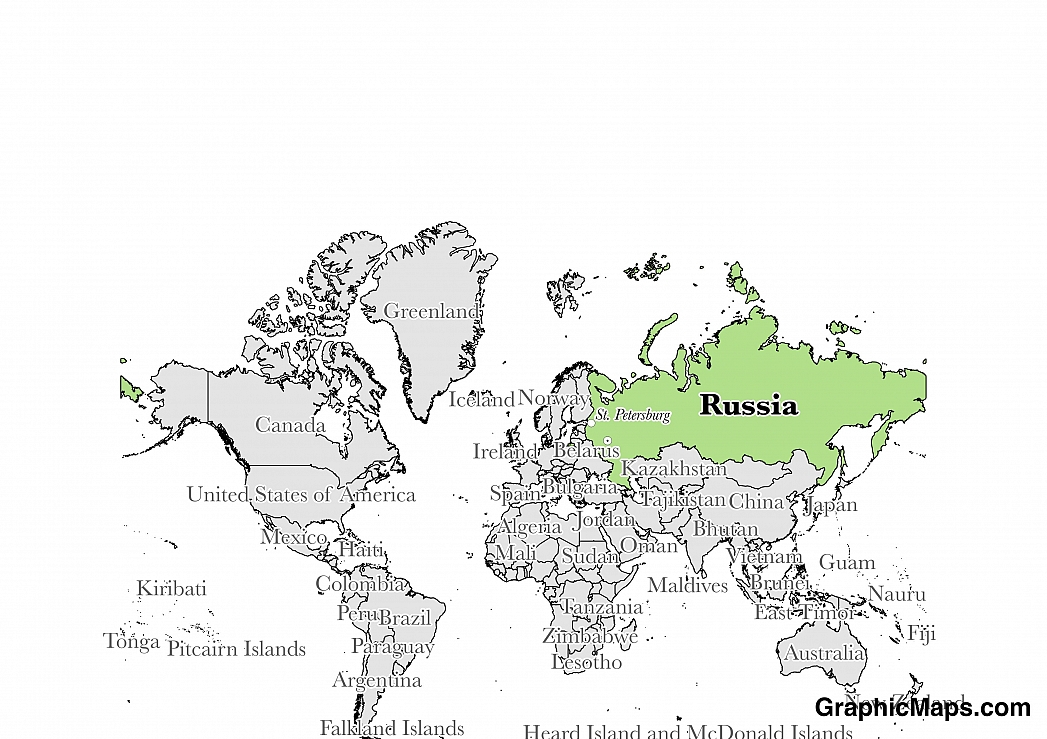Where is Russia?
Located in North Asia, Russia has a 22,408.00 km border with Azerbaijan (338 km), Belarus (1,312 km), China (southeast) (4,133 km), China (south) (46 km), Estonia (324 km), Finland (1,309 km), Georgia (894 km), Kazakhstan (7,644 km), North Korea (18 km), Latvia (332 km), Lithuania (Kaliningrad Oblast) (261 km), Mongolia (3,452 km), Norway (191 km), Poland (Kaliningrad Oblast) (210 km) and Ukraine (1,944 km). It has a 37,653.00 km coastline. Russia remains concerned about the smuggling of poppy derivatives from Afghanistan through Central Asian countries.
Moscow is a historic city which has served as Russia’s capital since just after the 1917 Russian Revolution when Lenin moved it from St. Petersburg. The city, which is the coldest and most northern urban municipality in the world, is home to over twelve million residents. Major landmarks in Moscow have been erected as a means of honoring and paying tribute to the city’s rich cultural past. The Kremlin, the official residence of the President of Russia, is one of the most popular sites in the entire country. Newer attractions include both the Ostankino and Federation Towers. Moscow’s hemiboreal climate is characterized by long cold winters and warm summers.
Read more on Russia's CapitalRussia is a European country covering 17,098,242.00 km2 of which 4.21% is water and 16,377,742.00 km2 is land. This makes it the largest country in the world and approximately 1.8 times the size of the US. Its geographic coordinates are 60 00 N, 100 00 E and Moscow is the capital city.
The name Russia, named for the viking Rus, was chosen to invoke patrimony across Russia.
Its ISO code is RU.
Geography
Russia has a mean elevation of 600 m above sea level.
It has a temperate climate with two rainy seasons, from February to April and November to January. The terrain is made up of low hills, vast forests, tundra, uplands, and mountains.
Population
Russia has a population of 142,355,415 making it the 9th largest in the world. The majority of the country lives near either the Baltic Sea or the Caspian Sea.
Russian is the official language. The major ethnic group reported is Russian. The majority of the country is Russian Orthodox Christian, with a significant Muslim population. A significant minority is also non-religious.
The Russian language is one of only four East Slavic languages still spoken today. Its roots trace back to the Indo-European language family and are made up of a Cyrillic 33 letter alphabet. Over time, some characters have evolved and merged with others to form new letters. Local dialects in Russia differ depending on the geographical region. Common phrases, such as greetings, must be adapted to fit specific times and occasions. Many terms also differ depending upon which gender is being addressed. The nation is also home to a variety of minority languages such as Ukrainian and Tatar.
Read more on Russia's LanguagesThe dialing code for the country is 7.
Government
Russia is an independent country. It gained independence with the dissolution of the Soviet Union in 1991. Its constitution was last ratified in 1993.
Since the collapse of communism, Russia has assumed the official status of a federation with an elected president as its head of state. The president has the duty of appointing the country’s prime minister. Citizens can chose candidates from several parties to represent their interests in government. The administrative business of government is conducted in the Russian White House, formally known as The House of the Government of the Russian Federation, which was built from 1965 to 1981 and designed by two local architects. The country’s Federal Assembly is divided into the State Duma and the Federal Council.
Read more on Russia's GovernmentEconomy
Factoring in Purchasing Power Parity, Russia's GDP is $3,750,000,000,000.00 (USD) with $26,100.00 (USD) per capita. This makes it the 6th largest economy and its citizens the 69th richest in the world. The currency of Russia is the Ruble (RUB).
Its major export partners are the Netherlands, China, and Germany. Its main exports are petroleum and petroleum products, natural gas, metals, and wood. Its major import partners are China, Germany, and the United States. Its major imports include machinery, vehicles, pharmaceutical products, plastic, and semi-finished metal products.
Flag
Russia’s history is marked by violent revolution and turbulent political change. The modern Russian flag dates back to a time in history when the nation was ruled by the all-powerful Tsars. Peter I adopted the tri colored flag after being inspired by that of the official flag of the Netherlands. Following the communist revolution, Russia was known as the USSR and adopted the familiar red flag featuring a hammer which was representative of the urban industrial workers, the sickle, which stood as a symbol of the rural peasants, and the star referring to the Communist party. Following the collapse of the Soviet Union the country once again adopted the traditional white, blue, and red flag design.
Read more on Russia's FlagThis page was last modified on January 17th, 2018
More on Graphicmaps

Published on 2019-11-06
What is a Trade Embargo?

Published on 2019-11-04
Which Two Countries Used to Have the Same Flag?

Published on 2019-09-16
What Is the Only Two-Sided State Flag?

Published on 2019-09-16
Which Country Flag Looks Like the Texas Flag?

Published on 2019-08-29
Flags That Resemble the US Flag

Published on 2019-08-20
